I'm using a client library for accessing a 3rd party API. The library was generated by NSwagStudio from Swagger documentation.
The app I'm working on is entirely synchronous in all its calls and updating it to be async is out of scope of what I'm working on.
When I test the client library from a unit test, it works fine. When I try to call it from within an ASP.Net app, I get the following error:
The CancellationTokenSource has been disposed.
I've distilled the client library down to the essentials for demonstrating the problem, I selected an option to provide sync methods as well as async:
public class ClientApi
{
private readonly HttpClient _httpClient;
public ClientApi(HttpClient httpClient)
{
_httpClient = httpClient;
}
public string BaseUrl { get; set; }
public object Get()
{
return Task.Run(async () => await GetAsync(CancellationToken.None)).GetAwaiter().GetResult();
}
/// <returns>OK</returns>
/// <param name="cancellationToken">
/// A cancellation token that can be used by other objects or threads to receive notice of
/// cancellation.
/// </param>
public async Task<string> GetAsync(CancellationToken cancellationToken)
{
var client_ = _httpClient;
try
{
using (var request_ = new HttpRequestMessage())
{
request_.Method = new HttpMethod("GET");
request_.RequestUri = new System.Uri(BaseUrl, System.UriKind.RelativeOrAbsolute);
var response_ = await client_.SendAsync(
request_,
HttpCompletionOption.ResponseHeadersRead,
cancellationToken
).ConfigureAwait(false);
try
{
// Exception occurs on following line
var responseData_ = response_.Content == null
? null
: await response_.Content.ReadAsStringAsync().ConfigureAwait(false);
return responseData_;
}
finally
{
response_?.Dispose();
}
}
}
finally { }
}
}
Here's the code that calls it:
protected void OnClick(object sender, EventArgs e)
{
var httpClient = new HttpClient();
var client = new ClientApi(httpClient)
{
BaseUrl = "https://www.google.com"
};
var html = client.Get();
}
The code calling this is just an asp.net page with a button, and the button events runs the same code as the unit test that passes.
When I compare the runs in a debugger: from a unit test, the response_.Content object does not have a cancellation token, however when run from asp.net it does. In fact they almost seem to be different objects, despite the fact GetType() reports them both as being System.Net.Http.StreamContent. From decompiling the class, this doesn't have a _cancellationtoken property, so where is the debugger getting it from?
I'm guessing that the http request to my asp.net web app has it's own token and source, that is somehow getting used by the HttpClient. However, the client is awaiting all the async calls to get the result synchronously, so I don't understand how the underlying CTS could be disposed as we haven't returned from the call the client library yet.
Can anyone understand what's happening and is there a resolution?

